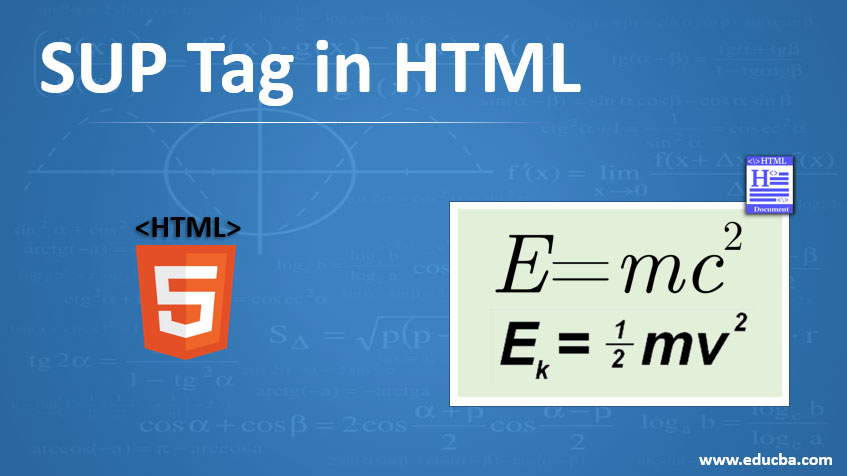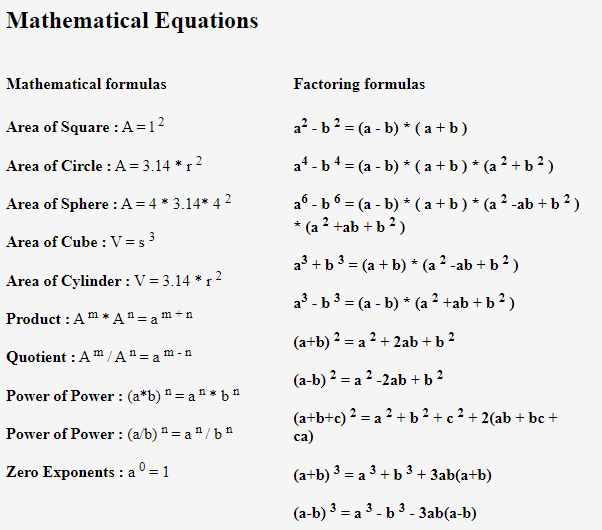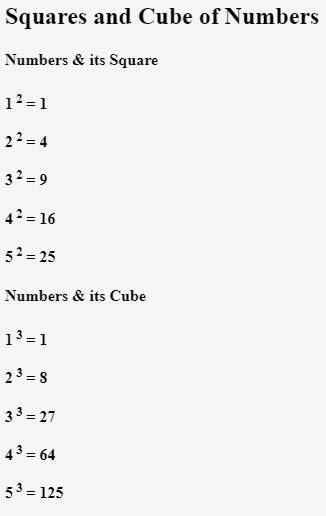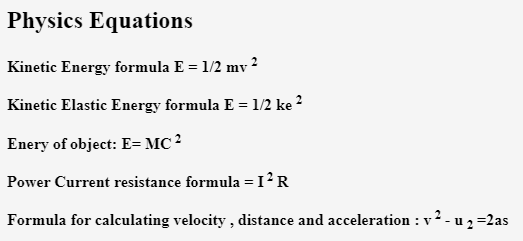Updated June 15, 2023
Introduction to SUP Tag in HTML
SUP Tag in HTML adds superscript text to the HTML document. SUP is an abbreviation of superscript text. It finds primary usage in HTML languages for representing mathematical expressions and scientific formulas. The placement of the SUP tag is in the half position of its character’s height upon baseline. It serves exclusively for typographical purposes. Another use of this tag is to show footnotes.
The text enclosed between <sup>.. </sup> shows superscript text in smaller font sizes in inline text format. It is a common practice to utilize it for displaying exponents, indicating the power of numbers in the text representation.<sup> tag doesn’t have any special attributes, but it supports global and event attributes.
Syntax:
To use the sup tag in HTML, follow the syntax below:
<sup> text </sup>- As shown in the above syntax, the text in between the <sup> tag is considered a superscript for the text. People use it in mathematical formulas and specific scientific equations.
- Example: <p>5<sup>2</sup> = 25</p>
- HTML sup tag supports global attributes like accesskey, class, data-*, dir, conenteditable, draggable, dropzone, hidden, id, lang, spellcheck, style, tabindex, title, translate, etc.
- It also supports event attributes like onafterprint, onbeforeprint, onerror, onbeforeunload, onhashchange, onload, onmessage, ononline, onoffline, onpagehide, onpopstate, onpageshow, onpagehide, onresize, onunload, onstorage and many more.
Examples of SUP Tag in HTML
You can also use the sup tag to display a stylish wordmark for business or product purposes. It can be done using CSS, too; we are not using the sup tag in this. An example of this is as follows:
Example #1
Let’s see how mathematical equations can be written using the <SUP> tag. An example includes various mathematical formulas, as shown below:
Code:
<!DOCTYPE html>
<html>
<head>
<meta name="viewport" content="width=device-width, initial-scale=1">
<style>
* {
box-sizing: border-box;
}
.column {
float: left;
width: 40%;
}
</style>
</head>
<body>
<div class="row">
<h2>Mathematical Equations</h2>
<div class="column">
<h4>Mathematical formulas</h4>
<p> <b> Area of Square :</b> A = l <sup> 2 </sup></p>
<p> <b> Area of Circle :</b> A = 3.14 * r <sup> 2 </sup></p>
<p> <b> Area of Sphere :</b> A = 4 * 3.14* 4 <sup> 2 </sup></p>
<p> <b> Area of Cube :</b> V = s <sup> 3 </sup></p>
<p> <b> Area of Cylinder :</b> V = 3.14 * r <sup>2</sup></p>
<p> <b> Product :</b> A <sup> m </sup> * A <sup> n </sup> = a <sup>m + n</sup></p>
<p> <b> Quotient :</b> A <sup> m </sup> / A <sup> n </sup> = a <sup>m - n</sup></p>
<p> <b> Power of Power :</b> (a*b) <sup> n </sup> = a <sup> n </sup> * b <sup> n </sup>
<p> <b> Power of Power :</b> (a/b) <sup> n </sup> = a <sup> n </sup> / b <sup>n</sup></p>
<p> <b> Zero Exponents :</b> a <sup> 0 </sup> = 1</p> <br>
</div>
<div class="column" >
<h4> Factoring formulas </h4>
<p> <b> a<sup>2</sup> - b <sup>2</sup> = (a - b) * ( a + b ) </b> </p>
<p> <b> a<sup>4</sup> - b <sup>4</sup> = (a - b) * ( a + b ) * (a <sup>2</sup> + b <sup>2</sup> ) </b> </p>
<p> <b> a<sup>6</sup> - b <sup>6</sup> = (a - b) * ( a + b ) * (a <sup>2</sup> -ab + b <sup>2</sup> ) * (a <sup>2</sup> +ab + b <sup>2</sup> ) </b> </p>
<p> <b> a<sup>3</sup> + b <sup>3</sup> = (a + b) * (a <sup>2</sup> -ab + b <sup>2</sup> ) </b> </p>
<p> <b> a<sup>3</sup> - b <sup>3</sup> = (a - b) * (a <sup>2</sup> +ab + b <sup>2</sup> ) </b> </p>
<p> <b>(a+b) <sup>2</sup> = a <sup>2</sup> + 2ab + b <sup>2</sup> </b> </p>
<p> <b> (a-b) <sup>2</sup> = a <sup>2</sup> -2ab + b <sup>2</sup> </b> </p>
<p> <b> (a+b+c) <sup>2</sup> = a <sup>2</sup> + b <sup>2</sup> + c <sup>2</sup> + 2(ab + bc + ca) </b> </p>
<p> <b> (a+b) <sup>3</sup> = a <sup>3</sup> + b <sup>3</sup> + 3ab(a+b) </b> </p>
<p> <b> (a-b) <sup>3</sup> = a <sup>3</sup> - b <sup>3</sup> - 3ab(a-b) </b> </p>
</div>
</div>
</body>
</html>Output:
Example #2
Showing squares and cubes of the numbers in <SUP> tag.
Code:
<!DOCTYPE html>
<html>
<head>
<meta name="viewport" content="width=device-width, initial-scale=1">
</head>
<body>
<h2>Squares and Cube of Numbers</h2>
<h4>Numbers & its Square</h4>
<p> <b> 1<sup> 2 </sup> = 1</b> </p>
<p> <b> 2<sup> 2 </sup> = 4</b> </p>
<p> <b> 3<sup> 2 </sup> = 9</b> </p>
<p> <b> 4<sup> 2 </sup> = 16</b> </p>
<p> <b> 5<sup> 2 </sup> = 25</b> </p>
<h4>Numbers & its Cube</h4>
<p> <b> 1<sup> 3 </sup> = 1</b> </p>
<p> <b> 2<sup> 3 </sup> = 8</b> </p>
<p> <b> 3<sup> 3 </sup> = 27</b> </p>
<p> <b> 4<sup> 3 </sup> = 64</b> </p>
<p> <b> 5<sup> 3 </sup> = 125</b> </p>
</body>
</html>Output:
Example #3
<SUP> tag is used to represent physical equations, as shown below.
Code:
<!DOCTYPE html>
<html>
<head>
<meta name="viewport" content="width=device-width, initial-scale=1">
</head>
<body>
<h2>Physics Equations</h2>
<p><b>Kinetic Energy formula E = 1/2 mv <sup> 2 </sup></b> </p>
<p><b>Kinetic Elastic Energy formula E = 1/2 ke <sup> 2 </sup></b> </p>
<p> <b> Enery of object: E= MC<sup> 2 </sup> </b> </p>
<p><b>Power Current resistance formula = I<sup> 2 </sup> R</b> </p>
<p><b> Formula for calculating velocity , distance and acceleration : v<sup> 2 </sup> - u <sub>2 </sub> =2as</b> </p>
</body>
</html>Output:
Conclusion
Here we learned that the <SUP> tag in HTML code represents superscription text in its related HTML document. Users primarily utilize this tag for mathematical expressions, scientific equations, and displaying language abbreviations. It offers text in half of the below-normal line and is in a smaller text size.
Recommended Articles
This is a guide to SUP Tag in HTML. Here we discuss what is SUP Tag in HTML, along with different examples and code implementation. You may also look at the following articles to learn more –





